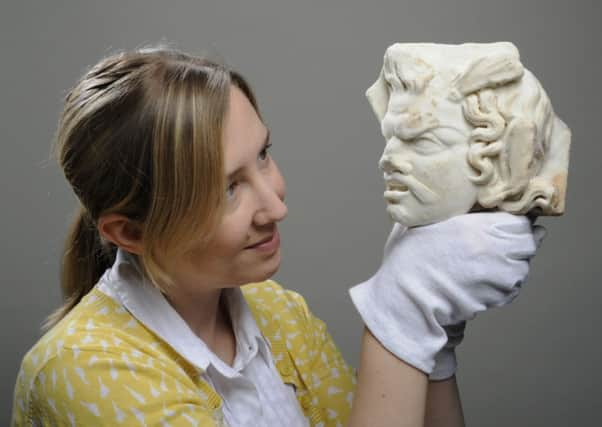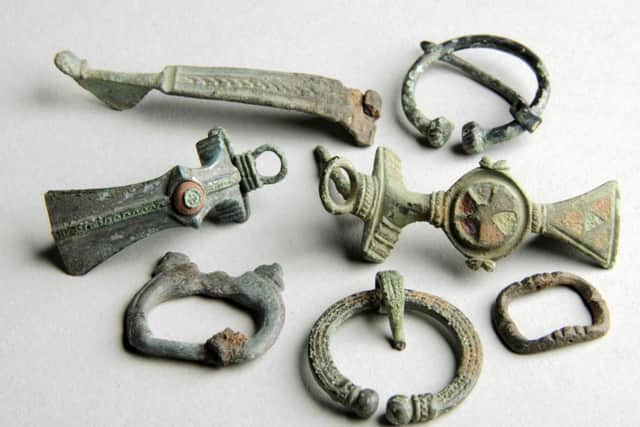The empire strikes back


A NEW star is on his way to Leeds City Museum. “There he is, that’s our poster boy,” says curator of archaeology Katherine Baxter, pointing to a photograph of a statue of Hercules. What he lacks in height he makes up for importance.
The statue is among 160 objects from the British Museum’s Roman Collection that are heading north and while he is only 50cm tall, like any good poster boy he comes with a degree of controversy. Some experts have previously suggested that he isn’t Roman at all, but Etruscan, Renaissance, or heaven forbid, even a modern copy.
Advertisement
Hide AdAdvertisement
Hide AdWhen we speak, Hercules, along with the rest of the collection, is about to hit the motorway after showing in Coventry and the team at Leeds are prepared for the inevitable last-minute dash to opening.


“With an event like this, it all comes together in the last few days,” says Katherine, as we wander around the rooms which next weekend will be hosting one of the museum’s most important exhibitions to date. “Because it’s a touring exhibition there is an element of flexibility and every museum has a chance to make it their own. Until a week or so ago, this space had been used as a gallery for an exhibition of wildlife paintings, so when the Roman collection arrives we will really just have five days before we open to the public. I know it doesn’t look like it, but a lot of the preparation has already been done. Cabinets have been built and we’ve mapped out the entire display, but there’s only so much you can do until the objects arrive.”
The team at Leeds have become pretty skilled at staging these high-profile events. Two years ago, another British Museum exhibition, Pharaoh: King of Egypt, which showcased more than 130 objects, enjoyed the highest first-week visitor numbers of any exhibition held at the museum. By the end of the four-month run almost 75,000 people had passed through the doors.
“I think it showed us what an appetite there is for history out there and we’d like to think the Romans will do just as well, if not better,” says Katherine. “A few years ago, before the major restoration project which provided a brand new museum for Leeds, we just wouldn’t have had the room to stage an exhibition like this, but now anything is possible.”
Advertisement
Hide AdAdvertisement
Hide AdToday it’s hard to believe that for the best part of a decade a city the size of Leeds was without its own museum. Since the 1940s the collections established by the Leeds Philosophical and Literary Society were housed in the section of the central library, but its new home, just off Millennium Square, has not only given it more space, but also increased leverage when it comes to collaborating with heavyweights like the British Museum.
Highlights of Roman Empire: Power and People include sculpture from the villas of the Emperors Tiberius and Hadrian, coins from the famous Hoxne treasure, rare jewellery and even near-perfectly preserved children’s clothing from Roman Egypt.
“When most people think of the Roman Empire they naturally think of iconic places like the Colosseum and they think of the soldiers, the emperors and the gladiators,” adds Katherine. “One of the aims of this exhibition is to show the real breadth of the empire and the many different people who lived within it, stretching from northern Britain right across to Egypt and the Middle East.
“As well as the pieces from the British Museum collection, we have added artefacts from our own stores, which hopefully tell a story of ordinary people and what Leeds was like during that era.”
Advertisement
Hide AdAdvertisement
Hide AdWhile many experts believe that the site of the modern city would have been occupied by Romans, no evidence of a full settlement has ever been uncovered.
“It is one of those real mysteries that make archaeology so fascinating. Unlike in York where the Roman occupation is well documented, there are so many pieces of the jigsaw missing when it comes to Leeds,” says Katherine. “However, while we have never been able to pinpoint a major settlement, a number of digs just a few miles away from the city centre have helped build up a picture of that period of history. Dalton Parlours, near Wetherby, is the only excavated example of a Roman villa in West Yorkshire; Adel, which was first excavated in the early 18th century, we know had a chapel and a number of houses; and then there’s my personal favourite – Lingwell Gate. At the site, near Wakefield, archaeologists found coin moulds and the suggestion is there was a forging operation going on. I just love the fact that all those centuries ago, people were sneaking their own money into circulation. It’s those kind of stories that for me really make history come alive.”
Like all other sectors, in recent years cultural attractions have faced increased pressure on budgets, with many organisations forced to justify their existence. It’s one of the reasons why Katherine is so pleased that the museum committed to ensuring the Roman exhibition was free.
“It is difficult, these kind of events are expensive to stage and a number of the other museums on the tour have taken the decision to charge. I understand that, we all have to juggle budgets, but the fact that in Leeds there will be free entry is just great, it’s about making sure history is open to all.”
• Roman Empire: Power and People, Leeds City Museum, September 20 to January 4. 0113 247 8256, www.leeds.gov.uk/museumsandgalleries.